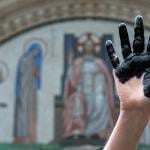LET US MURNAU PRAISE FAMOUS MEN: Sorry! Sorry! Anyway, I got this email from a friend, in re this post: Everyone is entitled to an opinion, but to describe the camera work in The Last Laugh as “nothing special” is factually incorrect. There are at least two great shots in the film: the opening ride down the elevator, through the lobby, and out onto the street (cameraman on a bicycle), and a view through a window, down to a courtyard, finishing in close-up (camera on a pulley-rope). Plus many other instances when the camera leaves the tripod behind or crouches at odd angles; this remains one of the most mobile cameras in film. Maybe it’s not your thing, but it is certainly special.
Once sound came in, cameras had to be put in cages, lest their noise make it onto the soundtrack, and Murnau’s brand of creativity largely disappeared for most of the ’30s. Only later, with quieter cameras, more sophisticated sound systems, redubbing, zoom lenses, Steadycams, and other gadgets, were cameras freed again. Yet even then, the truly great shots remained silent (that is, accompanied by music, not dialogue), including the greatest moving-camera shot of all time: the opening of Touch of Evil (1957). Even today, you will find crummy movies (Return to Me) with magnificent opening shots, thanks to the crane- or helicopter-mounted zoom lenses that no doubt filled Murnau’s dreams.
The film’s ending is, alas, indefensible. But that’s Hollywood. Or UFA. Whatever.
OK, here’s the deal: I didn’t notice cool camerawork, and I was looking. “Cool camerawork,” for me, is defined as camerawork that in some way illuminates what’s going on; makes the movie visually more striking (to me); makes me go “oooh!”; in about that order. What I like best in camerawork: a combination of subject matter, angle, and lighting that either underlines the point of a scene or, better yet, shows the scene’s subtleties and complexities. I like both very sensual or thing-focused camerawork, and also camerawork that forms a counterpoint to the scene (am I using that term right?), kind of the way the guitar and bass often play differing and almost opposing, but complementary, lines in Smiths songs.
All of the above is not to say that “The Last Laugh” was not groundbreaking. I’m sure I missed things. I’m also sure I was judging the movie pretty harshly because a) I wasn’t particularly sold on the plot or characters, so I was looking hard for other things to be interested in; b) I had high expectations for Murnau; and c) I had relatively recently seen “The Bat Whispers,” a later movie but with (to those of us who know little about film history) a similar old-timey “feel.” TBW is a fun, cool movie, and includes several showy but not-unrelated-to-the-plot camera swoops and angle choices. Perhaps the most important reason I missed all the good stuff going on with TLL’s cameras is simply that I don’t know enough about film history to know what is groundbreaking. But for whatever reason, even trawling my memory of the movie I can’t come up with any directorial choices that seemed to enhance or deepen the movie. But I’ve only watched it once; I defer to the judgment of people who know the period and the movie itself better than I do.











